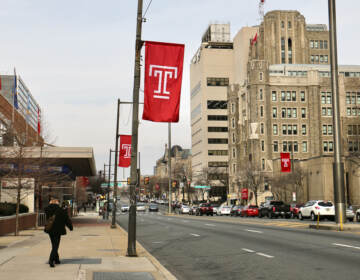Study: Pa. students seem to prefer charter schools dominated by members of their own race
Listen
(Emma Lee/WHYY, file)
Few topics in education inspire more debate than school choice and school integration.
A new study co-authored by Penn State professors combines the two and reaches an eye-raising conclusion: When Pennsylvania students move from traditional public schools to charters, they tend to choose charters that are more racially homogeneous than the schools they left behind.
Black students, in other words, pick charters that are more heavily African-American than their former public schools. The same goes for Latino students.
Students choose these schools, the study authors found, even when nearby charters weren’t as disproportionately dominated by members of their own race.
“Findings indicate that, holding distance and enrollment constant, black and Latino students are strongly averse to moving to charter schools with higher percentages of white students,” the study’s authors wrote. “White students are more likely to enroll in such charter schools.”
The findings, published Monday in the academic journal Education Policy Analysis Archives, were based on a data set of more than 8,000 Pennsylvania students who first attended charters in the 2011-12 school year. More than three-quarters of the students in the analysis went to charter schools in Philadelphia.
This isn’t the first study to link school choice and racial segregation. But it is designed to rebut a central critique of past academia in this area — namely that charter schools are more segregated because they’re located in already-segregated neighborhoods.
The authors of this latest analysis wanted to test that theory.
To do so they examined how far students travelled from their home school when picking a charter and whether they tended to pick the closest school. The answer was no.
“In fact, the average distance to a chosen charter school was at least twice as far as the nearest charter school for black and Latino students regardless of age group,” the authors wrote.
The study also looked at other choices students had when opting for a charter. They considered any school within a 10-mile radius of the student’s home school to be a potential choice (a relatively generous definition in densely populated cities such as Philadelphia). They then determined how many choices for the average student fit into one of five demographic categories: 0-20 percent white; 20-40 percent white; 40-60 percent white; 60-80 percent white; and 80-100 percent white.
In all, they found most minority students did have choices that were in the 0-40 percent white range or the 60-100 percent white range.
On the flip side, they also found that for black and Latino students, overwhelmingly white charters tended to be about twice as far away as overwhelmingly nonwhite schools.
There is a lot to unpack, and it’s a study that raises important issues. We reached out to lead author Erica Frankenberg, an education professor at Penn State University, for some follow-up questions.
The answers are edited and condensed for clarity.
Big picture, what did you find?
We found that, for black and Latino students, they were leaving traditional public schools that were fairly highly racially segregated [and] moved to charter schools that were even higher in segregation. So, on average, they went to charter schools that had 12 percent more students of their own race. So that’s a fairly high jump.
For white students, it was mixed depending on what grade levels we were looking at. Basically, it washed out to being equal.
We saw some really interesting patterns when we looked at the choices they had. We saw — particularly in Philadelphia but in other metropolitan areas, as well — that students had a lot of different charter school options. Second, they didn’t necessarily choose the charter school that was closest. We think of proximity as important, and it is. But they were obviously willing to go beyond the nearest charter school for various reasons.
And, third, we saw that black and Latino students tended to choose the schools that had lower white percentages. We saw the opposite finding for white students. They preferred enrolling in choices that were 60 to 100 percent white.
So you’re essentially saying they might have bypassed options that were more racially diverse for schools that were less racially diverse? Or could you conclude that based on the analysis you did?
We couldn’t exactly conclude that.
One of the things I found really surprising is the percentage who went to schools that weren’t the closest. We don’t necessarily know whether they were more integrative. In fact, one of the really interesting findings is that we divided charter schools into quintiles. There were the fewest options for most diverse. So we either had heavily white options or we had heavily nonwhite options.
Those diverse options didn’t actually exist. Now they were bypassing options in which their enrollment would have made the school more diverse. But we don’t know if that happened to be the one that was closest to them.
You don’t in this analysis seem to speculate on why people make these choices — whether it’s the marketing that the charter schools do that encourages this trend or whether it’s the parents and families themselves who prefer more racially segregated schools. Do you have any guesses?
The mark of any interesting study is that it creates a lot more questions that you can’t answer yet. What I really appreciated about this study in comparison to the rest — including others that I’ve done in this area — is that we are at least able to look at kind of what are the supply of charter school options that charter school movers had. That’s something we haven’t been able to look at before.
But we don’t know why they are making those choices. I think it would require some in-depth, qualitative work to survey parents.
When you considered what schools should be termed viable choices for a family, you included schools within a 10-miles radius. Did I get that right?
Yes. That’s right.
On that point, Pennsylvania law provides transportation at free cost to parents if you choose a charter school within your school district or up to 10 miles beyond your school district. So that’s why we felt like 10 was a fair radius to think about in terms of what parents were actually considering.
Did you weight the choices based on how far they were or consider them all choices so long as they were within that radius?
We considered them all. But that’s why we also included a distance variable in order to be able to both account for composition and distance for the student at the same time.
Since Philadelphia is such a huge part of this sample size, I’m curious if you worry about making that set of schools too large. Ten miles away, schools that are on the outer edge of that range are really not a viable choice in a really densely populated area — and also in an area where you’re more likely to be commuting by public transportation as opposed to being in a car. Does that make sense?
Yeah. Just a couple points.
One is we looked at these findings for both the Philadelphia metro and all other students in the rest of the state because there are a number of unique contextual factors to Philadelphia. We didn’t want that to influence our sample and the conclusions because Philadelphia stands for such a larger percentage. So we found similar patterns, whether it was in the Philadelphia metropolitan area or other metropolitan areas around the state.
To your last point on what was an actual choice or not. That’s something we gave a lot of thought to and did some exploratory analyses to see whether our results were different based on different kinds of radii.
Obviously 10 miles can mean a lot of different things even within Philadelphia. Ultimately, we decided to go just on geography versus thinking about commuting time. But certainly that would also be a really interesting way to approach this, as well.
Do you know of anyone who has tried to do this analysis looking at magnet schools and other public schools that don’t have neighborhood catchment areas associated with them? Do they find similar results?
There is one study that we cited. And it did find that higher percentages of black and Latino students made magnet schools and other public schools less desirable. That’s one study.
I’ve studied the Louisville, Kentucky, school district which is in the news right now because Kentucky’s trying to end its choice policy and return them to neighborhood schools. And one of the really interesting things is that a lot of parents are choosing schools outside of their neighborhood to send their kids. And this is an area with very deep residential segregation.
So that’s a really interesting district to look at to think about. They don’t have any charter schools there yet, but to look at how a choice system within the school district is having some very different choice patterns by parents.
WHYY is your source for fact-based, in-depth journalism and information. As a nonprofit organization, we rely on financial support from readers like you. Please give today.





